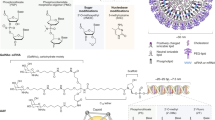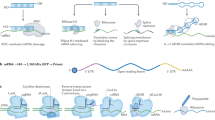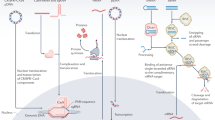Abstract
The unique properties of oligonucleotide (and small interfering RNA)-modified gold nanoparticle conjugates make them promising intracellular gene regulation agents. We found that gold nanoparticles stably functionalized with covalently attached oligonucleotides activate immune-related genes and pathways in human peripheral blood mononuclear cells, but not an immortalized, lineage-restricted cell line. These findings have strong implications for the application of oligonucleotide-modified gold nanoparticle conjugates in translational research and in the development of therapeutics and gene delivery systems.
This is a preview of subscription content, access via your institution
Access options
Subscribe to this journal
Receive 12 print issues and online access
$259.00 per year
only $21.58 per issue
Buy this article
- Purchase on Springer Link
- Instant access to full article PDF
Prices may be subject to local taxes which are calculated during checkout



Similar content being viewed by others
References
Rosi NL, Giljohann DA, Thaxton CS, Lytton-Jean AK, Han MS, Mirkin CA . Oligonucleotide-modified gold nanoparticles for intracellular gene regulation. Science 2006; 312: 1027–1030.
Fox BA, Drury M, Hu HM, Cao Z, Huntzicker EG, Qie W et al. Lipofection indirectly increases expression of endogenous major histocompatibility complex class I molecules on tumor cells. Cancer Gene Ther 1998; 5: 307–312.
Hornung V, Latz E . Intracellular DNA recognition. Nat Rev Immunol 2010; 10: 123–130.
Marano F, Hussain S, Rodrigues-Lima F, Baeza-Squiban A, Boland S . Nanoparticles: molecular targets and cell signalling. Arch Toxicol 2010.
Stacey KJ, Ross IL, Hume DA . Electroporation and DNA-dependent cell death in murine macrophages. Immunol Cell Biol 1993; 71 (Part 2): 75–85.
Brown DM, Dickson C, Duncan P, Al-Attili F, Stone V . Interaction between nanoparticles and cytokine proteins: impact on protein and particle functionality. Nanotechnology 2010; 21: 215104.
Janeway Jr CA, Medzhitov R . Innate immune recognition. Annu Rev Immunol 2002; 20: 197–216.
Hazarika P, Giorgi T, Reibner M, Ceyhan B, Niemeyer CM . Synthesis and characterization of deoxyribonucleic acid-conjugated gold nanoparticles. Methods Mol Biol 2004; 283: 295–304.
Dobrovolskaia MA, Germolec DR, Weaver JL . Evaluation of nanoparticle immunotoxicity. Nat Nanotechnol 2009; 4: 411–414.
Vallhov H, Qin J, Johansson SM, Ahlborg N, Muhammed MA, Scheynius A et al. The importance of an endotoxin-free environment during the production of nanoparticles used in medical applications. Nano Lett 2006; 6: 1682–1686.
Bright NA, Reaves BJ, Mullock BM, Luzio JP . Dense core lysosomes can fuse with late endosomes and are re-formed from the resultant hybrid organelles. J Cell Sci 1997; 110 (Part 17): 2027–2040.
Khan JA, Pillai B, Das TK, Singh Y, Maiti S . Molecular effects of uptake of gold nanoparticles in HeLa cells. Chembiochem 2007; 8: 1237–1240.
Mandal D, Maran A, Yaszemski MJ, Bolander ME, Sarkar G . Cellular uptake of gold nanoparticles directly cross-linked with carrier peptides by osteosarcoma cells. J Mater Sci Mater Med 2009; 20: 347–350.
Nativo P, Prior IA, Brust M . Uptake and intracellular fate of surface-modified gold nanoparticles. ACS Nano 2008; 2: 1639–1644.
Dominska M, Dykxhoorn DM . Breaking down the barriers: siRNA delivery and endosome escape. J Cell Sci 2010; 123 (Part 8): 1183–1189.
Massich MD, Giljohann DA, Seferos DS, Ludlow LE, Horvath CM, Mirkin CA . Regulating immune response using polyvalent nucleic acid-gold nanoparticle conjugates. Mol Pharm 2009; 6: 1934–1940.
Jiang W, Lederman MM, Hunt P, Sieg SF, Haley K, Rodriguez B et al. Plasma levels of bacterial DNA correlate with immune activation and the magnitude of immune restoration in persons with antiretroviral-treated HIV infection. J Infect Dis 2009; 199: 1177–1185.
Haiss W, Thanh NT, Aveyard J, Fernig DG . Determination of size and concentration of gold nanoparticles from UV-vis spectra. Anal Chem 2007; 79: 4215–4221.
Hochreiter S, Clevert DA, Obermayer K . A new summarization method for Affymetrix probe level data. Bioinformatics 2006; 22: 943–949.
Talloen W, Clevert DA, Hochreiter S, Amaratunga D, Bijnens L, Kass S et al. I/NI-calls for the exclusion of non-informative genes: a highly effective filtering tool for microarray data. Bioinformatics 2007; 23: 2897–2902.
Tusher VG, Tibshirani R, Chu G . Significance analysis of microarrays applied to the ionizing radiation response. Proc Natl Acad Sci USA 2001; 98: 5116–5121.
Yoav Benjamini YH . Controlling the false discovery rate: a practical and powerful approach to multiple testing. J R Stat Soc Series B (Methodol) 1995; 57: 289–300.
Dennis Jr G, Sherman BT, Hosack DA, Yang J, Gao W, Lane HC et al. DAVID: Database for Annotation, Visualization, and Integrated Discovery. Genome Biol 2003; 4 (5): P3.
Huang da W, Sherman BT, Lempicki RA . Systematic and integrative analysis of large gene lists using DAVID bioinformatics resources. Nat Protoc 2009; 4: 44–57.
Acknowledgements
The National Institutes of Health, the National Science Foundation, the United Kingdom Medical Research Council and the International Institute for Nanotechnology within Northwestern University supported this study. Data were presented at the 2009 meeting of the International Institute for Nanotechnology, Nanoscale Science and Engineering Center for Integrated Nanopatterning and Detection Technologies, Northwestern University. EK is the recipient of a Baxter Award from the Institute for BioNanotechnology in Medicine. RS is a Research Councils UK Academic Fellow. All patient samples were collected with Northwestern University Institutional Review Board (IRB) consent. We thank David Giljohann and Chad Mirkin for generously providing the gold nanoparticles stably functionalized with covalently attached oligonucleotides; Edward Campbell and Kelly Fahrbach for assistance with fluorescent microscopy; Robert Goldman and Lennell Raynolds for assistance with transmission electron microscopy; Carlos Nahas and Maurice O’Gorman for assistance with FACS analysis; and Jaejung Kim for assistance with the human microarrays. The microarray data have been deposited in the National Center for Biotechnology Information Gene Expression Omnibus (www.ncbi.nlm.nih.gov/geo) and are accessible through GSE 20677 Series accession numbers GSM518597 to GSM518609 and GSM535541 to GSM535543.
Author Contributions
E-YK, SMW and MHM planned and designed the project. E-YK, PS and KK performed the experiments and E-YK, RS, SMW analyzed the data. E-YK and PS performed experiments with PBMCs and the lineage-restricted 293T cell line, E-YK performed fluorescent microscopy and transmission electron microscopy, E-YK and PS performed the FACS analysis, E-YK and KK performed the RT-qPCR experiments, E-YK and PS performed human microarray experiments and RS performed the human microarray data analysis. E-YK, RS, MHM and SMW interpreted the results and drafted the manuscript. All the authors participated in critically reviewing the text and approved the final version of the manuscript.
Author information
Authors and Affiliations
Corresponding author
Ethics declarations
Competing interests
The authors declare no conflict of interest.
Additional information
Supplementary Information accompanies the paper on Gene Therapy website
Supplementary information
Rights and permissions
About this article
Cite this article
Kim, EY., Schulz, R., Swantek, P. et al. Gold nanoparticle-mediated gene delivery induces widespread changes in the expression of innate immunity genes. Gene Ther 19, 347–353 (2012). https://doi.org/10.1038/gt.2011.95
Received:
Revised:
Accepted:
Published:
Issue Date:
DOI: https://doi.org/10.1038/gt.2011.95
Keywords
This article is cited by
-
How toxic are gold nanoparticles? The state-of-the-art
Nano Research (2015)
-
RETRACTED ARTICLE: Surface-functionalized gold nanoparticles mediate bacterial transformation: a nanobiotechnological approach
Biotechnology Letters (2014)



